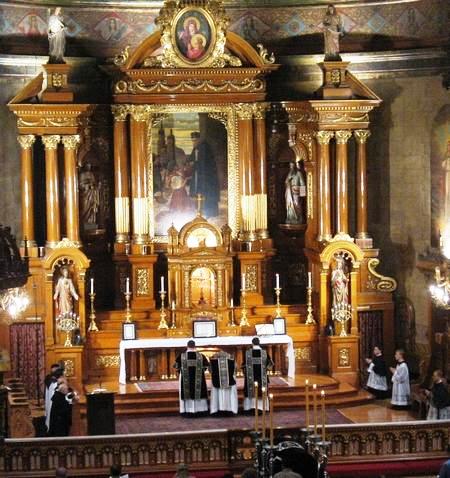"Give us back our black!"
Let this be the cry of the Catholic in the age of reclaiming continuity.
This is from a reader:
Photos from the first Tridentine Requiem in 43 years in the cavernous Upper Church of the Cathedral of the Holy Cross, Boston. The Tridentine Mass community moved to the Cathedral from Holy Trinity last July, and has been Celebrating the Mass every week in the Lower Church. On All Souls, there being no scheduling conflicts, the Chant High Requiem for the Feast day was Celebrated by Fr Agustin Anda (Parochial Vicar at St Columbkille, Brighton, who has been Celebrating the EF since the Motu Proprio) in the Upper Church, usually reserved for Ordinations, etc.
The Altar at the crossing was used, but Ad Orientem, Black Vestments (of course), Gregorian Chant throughout, and very well attended. Fr Anda Celebrated with great carefulness and dignity, and delivered a moving Homily on praying for our beloved departed.
November is an appropriate time to have Requiem Masses.
Another fine image is from Chicago, where at St. John Cantius they tend to do things right.

Here is an encouraging shot:
Fr. Z, here are some photos of my pastor in Black vestments. I’d posted a link but someone suggested I send the pictures to you. This is Fr. Paul Weinberger, St. William the Confessor, Greenville, Texas…Dallas Diocese
I am especially happy to see father’s tricorno and the chalice with veil and burse All is right with the world. There also seem to be an adequate number of angel statues.




































My heart skips a beat every time I see the altar of St. John Cantius.
A pity it’s in Chicago. *grins*
oh wow, is that gorgeous, if new church alters could be half that wonderful!!!
Please answer this for me. Do the black vestments predate the congregation wearing black for the funerals or did people wear black for funerals in pagan times and then the vestments became black out of custom?
Did anyone else see EWTN’s daily mass yesterday? Fr. Anthony wore black to celebrate the Franciscan All Souls and preached on Hell and its reality.
Are we allowed to finish the third iteration of the Agnus Dei with ‘dona eis requiem eternam’ in the OF?
Father Z, I was at the Mass at St. John Cantius and what was especially great news was that 2 priests from EWTN were there. It was announced by
Father Phillip that these two fine priests were there to study the TLM! Tom
Are we allowed to finish the third iteration of the Agnus Dei with ‘dona eis requiem eternam’ in the OF?
No, this is not part of the ordinary form. However, there was a grandfathering clause for vulgar 1965-1969 musical settings of the Mass at the time of the introduction of the inferior current, now lame-duck, English translations in 1970. So you could arguably include this phrase if it were part of a polyphonic requiem Mass already composed; I personally would not shrink from the Durufle “requiem sempiternam” if I ever had the option. (Note that the chant requiem has a corresponding non-requiem Agnus Dei; I would find it hard to justify using the requiem phrase in the case of an available alternative.)
If I and some other ladies of my parish got together and bought black vestments would they belong to the parish or would they go with pastor when he leaves?
Matt:
I saw the Mass at EWTN yesterday. Seeing them in black was very sobering but awe-inspiring. To cap it all off, the homily on Hell was absolutely needed and appropriate.
God bless Fr. Anthony and all the friars of EWTN.
Dymphna,
That would depend no whether you gave them to the parish or to the individual priest. That would be your choice–just make it clear in the gift.
That would depend on whether you gave them to the priest or to the parish. It’s you choice, just make it clear when you give them.
I would suppose that black vestments only became widely popular when black dyes became colorfast. Prior to that, you’d be stuck with wool garments derived from black-woolled sheep.
Now, it’s true that male Romans did wear black togas (and togas were wool) in time of mourning. Apparently they got this from the Greeks or the Greek side of Roman civilization. In Greek tragedies, black or very dark clothes also represent mourning. The idea probably was that bleached white clothes were totally pure, but black dyed clothes were dirty, like ashes, and also could not be dyed any other color afterward. Black was irrevocable. (And looked kinda cruddy when the colorfastness went away.)
So black as a color of mourning in the West goes pretty far back. But black vestments don’t. Before colorfastness, other colors were more fitting in the Lord’s house, because they didn’t look cruddy after a few washes.
Neither here nor there… it’s fascinating to see sharp clear digital pictures of EF celebrations. I was born in 1966 and have no recollection of the EF aside from low-quality B&W photos.